When exploring old headstones, you can discover stories through symbols that reveal beliefs, cultural identities, and memories. Respectfully approach each marker with sensitivity, observing religious icons, flowers, and personal emblems that convey deeper meanings. Handle the monuments carefully and avoid intrusive behavior to honor the memory of those buried. Continuing to observe and interpret these symbols with mindfulness helps you deepen your understanding of history and cultural traditions behind each memorial.
Key Takeaways
- Approach headstones with respect, maintaining a calm demeanor and observing cemetery etiquette to honor the deceased and their cultural traditions.
- Carefully observe symbols, motifs, and inscriptions to interpret personal, cultural, or religious meanings behind the headstone.
- Handle headstones gently during cleaning or inspection, using appropriate methods and avoiding damage to preserve their historical integrity.
- Recognize that symbols like crosses, angels, or floral motifs convey specific beliefs, emotions, and cultural values respectfully.
- Engage in silent reflection and avoid intrusive behaviors, fostering a mindful connection to the stories and memories reflected in the markers.
Understanding the Role of Symbols in Grave Markers
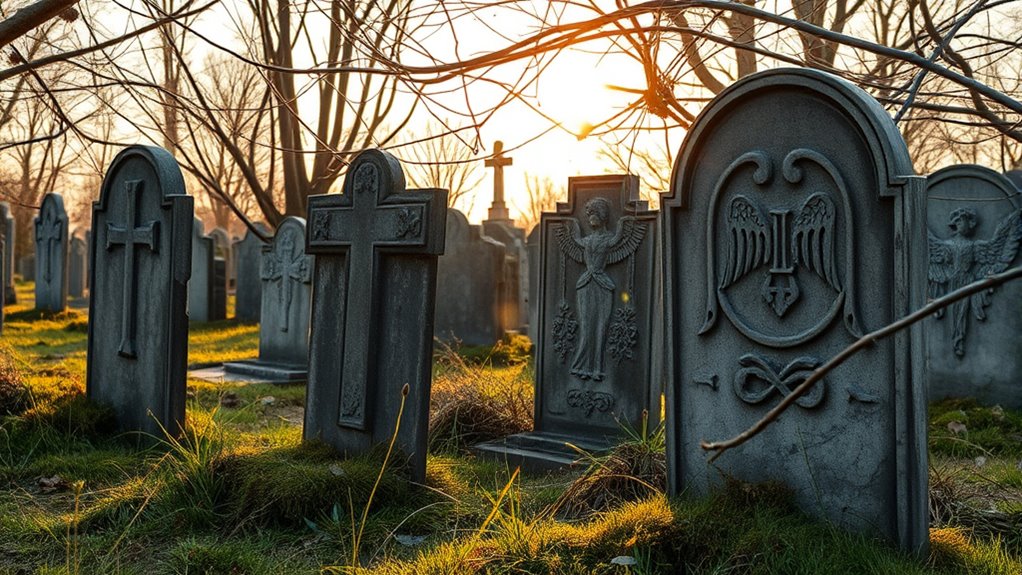
Have you ever wondered why certain symbols appear on grave markers? These symbols are essential elements of funeral art, playing a crucial role in memorial design. They communicate emotions, beliefs, and cultural values without words, offering comfort or reflection to visitors. Symbols like crosses, angels, or flowers are deliberately chosen to symbolize hope, faith, or remembrance. They help personalize the memorial, making it meaningful for loved ones and future generations. Recognizing these visual cues allows you to interpret the intent behind the memorial’s design, revealing deeper insights into the deceased’s life and the cultural context in which the grave was created. Additionally, understanding personality traits associated with different symbols can deepen your appreciation of their significance.
Common Motifs and Their Meanings
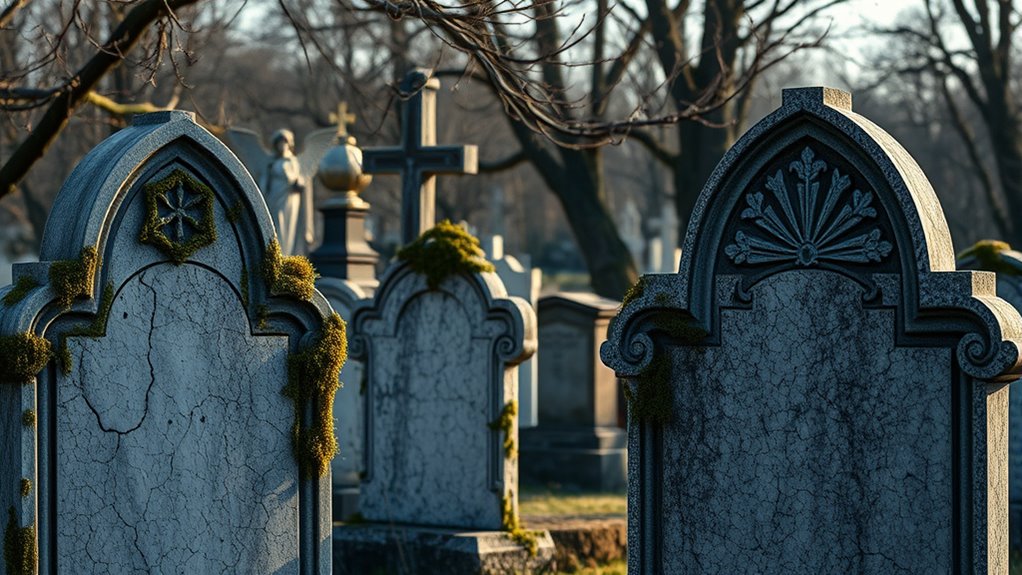
Many symbols found on grave markers carry specific meanings that reflect the beliefs, values, or personality of the deceased. Common motifs include ornamental carvings that symbolize faith, hope, or love, and are often paired with meaningful epitaph language. These symbols serve as visual messages, conveying sentiments that words may not fully express. To deepen your understanding, consider this table:
| Symbol | Meaning | Example |
|---|---|---|
| Cross | Faith, resurrection | Religious beliefs |
| Ivy | Eternal life, fidelity | Loyalty, remembrance |
| Doves | Peace, soul’s ascent | Spiritual purity |
Recognizing these motifs helps you appreciate the story behind each headstone beyond just inscriptions. Understanding the symbolic meanings] of these motifs can enhance your respect and connection to the history they represent.
Analyzing Religious and Spiritual Icons
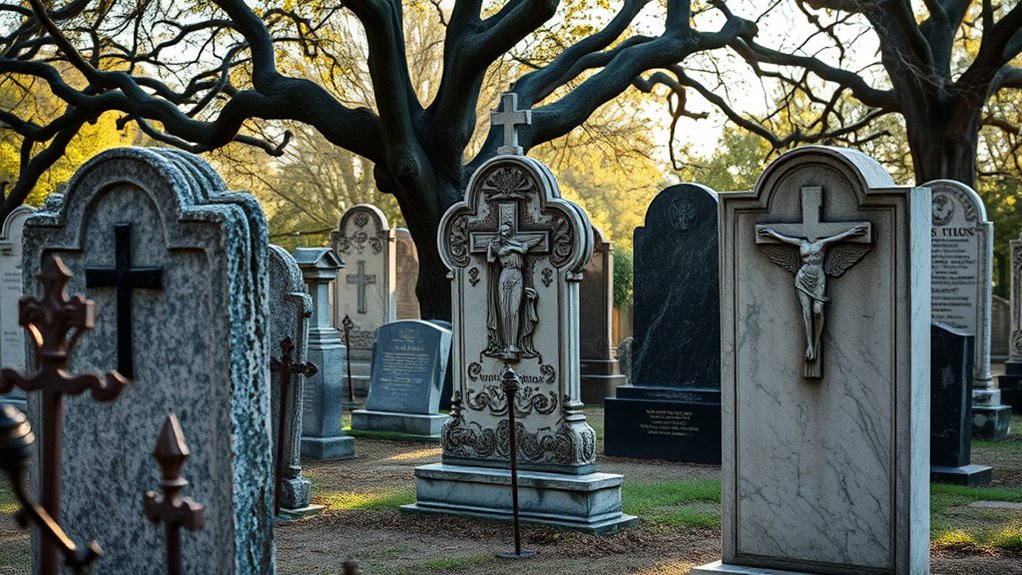
Religious and spiritual icons on grave markers serve as powerful symbols that communicate a person’s faith and beliefs beyond words. They reflect funeral customs and cemetery art that honor spiritual traditions and provide comfort to mourners. Crosses often symbolize Christian faith, while angels represent guardianship and divine presence. Symbols like the Star of David or lotus flowers can denote Jewish or Eastern spiritual beliefs. These icons help you understand the deceased’s religious background and the cultural context of their final rites. Pay attention to the placement and style of these symbols, as they reveal specific spiritual meanings and community values. Recognizing these icons allows you to appreciate the depth of faith expressed through cemetery art and better respect the person’s spiritual journey.
Interpreting Personal and Cultural Emblems
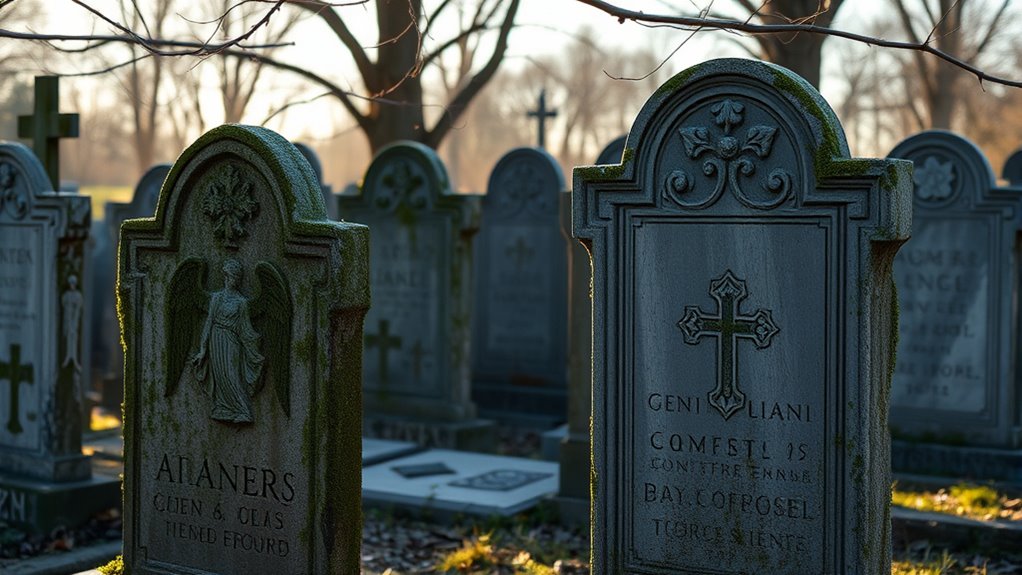
Personal and cultural emblems on grave markers provide a meaningful glimpse into the individual’s identity, values, and heritage. These symbols often reflect specific funeral traditions and memorial customs that honor the deceased’s background. For example, a family might include emblems representing their religious beliefs, cultural practices, or personal passions. Recognizing these symbols helps you understand the person’s life story and the community’s way of showing respect. Some emblems may indicate membership in a particular organization or adherence to specific customs. When interpreting these emblems, consider the context of the cemetery and the cultural significance behind the symbols. Respectful observation reveals the diversity of funeral traditions and deepens your appreciation for how communities honor their loved ones. Additionally, understanding vetted symbols can provide deeper insight into the historical and cultural context of the gravestone.
The Significance of Flowers and Natural Elements

Flowers and natural elements on grave markers serve as powerful symbols that convey emotions, beliefs, and memories. They often reflect garden imagery, creating a peaceful, natural setting that honors the deceased. Seasonal symbolism plays a key role, as specific flowers bloom at certain times, symbolizing renewal, mourning, or celebration. For example, lilies often represent purity and resurrection, while roses can signify love or grief. You might notice how different flowers are chosen to match the life and personality of the departed or the traditions of their culture. These natural elements serve as visual metaphors, connecting the living with the natural cycle of life and death. They remind us of the ongoing relationship between nature and memory. Additionally, the powerful symbolism of flowers in memorials enhances the emotional impact and helps facilitate mourning and remembrance.
Deciphering Age, Gender, and Status Indicators

You can learn a lot about a person from their gravestone, especially through age indicators in epitaphs and symbols of gender and status. These clues help you understand their life stage, social standing, and identity. Recognizing these markers reveals the stories behind each grave. Additionally, understanding common symbolic representations found on headstones can provide deeper insights into cultural and historical contexts.
Age Indicators in Epitaphs
Epitaphs often reveal essential clues about a buried individual’s life, especially through age indicators that help decipher their age at death, gender, and social status. These details often reflect the funeral traditions and burial customs of the time, providing insight into societal values. Pay attention to how ages are recorded—sometimes as exact years, sometimes as estimates or age ranges. Such markers can indicate whether the person was young or old, influencing the memorial’s tone. Age indicators may also be embedded in symbols or phrasing that align with specific periods and cultures. Recognizing these subtle hints helps you understand the person’s life story and the community’s customs. These details serve as crucial clues for respectful and accurate interpretations of old headstones. Additionally, understanding funeral customs can shed light on the significance of age markers in different cultures and eras.
Gender and Status Symbols
Have you ever noticed how symbols and phrasing on gravestones reveal not just age but also the buried person’s gender and social standing? Many headstones feature gender roles through specific symbols, like angels for women or military emblems for men, reflecting societal expectations. These markers also hint at social hierarchy, with elaborate carvings or family crests indicating higher status. You might see titles such as “Esq.” or “Rev.” that emphasize professional or social rank. Such details help you understand the person’s position in the social hierarchy and the gender roles they embodied during their lifetime. Recognizing these symbols allows for a deeper appreciation of the individual’s place in history and the cultural values that shaped their life and memorial. Additionally, vetted dog names can sometimes be found as part of personalized epitaphs, reflecting family traditions or pet memorials.
Respectful Observation and Cultural Sensitivity

When observing graveyards, it’s important to approach with a mindful attitude and respect for the cultural practices you encounter. Recognize that different traditions have unique symbols and rituals, and your sensitivity can make a meaningful difference. By observing quietly and with reverence, you honor the significance of these spaces for the communities they serve. Being aware of cultural symbols and their meanings can deepen your understanding and appreciation of the traditions represented.
Mindful Approach Matters
Approaching graveyard symbolism with respect and cultural sensitivity is essential to honoring the beliefs and traditions of others. You should always follow cemetery etiquette, such as speaking softly and avoiding disruptive behavior. When observing headstones, handle them carefully to avoid damage, practicing respectful headstone care. Keep in mind that each grave reflects personal or cultural significance, so be attentive to any symbols or inscriptions. Maintain a mindful attitude by refraining from taking photos without permission and avoiding intrusive gestures. Respect the space for visitors who come to mourn. By being considerate and aware, you ensure your presence honors the memory of those buried there and preserves the dignity of the site. Your thoughtful approach helps foster understanding and respect for diverse traditions. Additionally, understanding symbolic meanings behind various headstone markings can deepen your appreciation of different cultural practices and beliefs.
Respect Cultural Differences
Why is it important to recognize and respect cultural differences when observing graveyard symbols? Because different cultures have unique funeral practices and burial customs that influence how they honor the deceased. Understanding these cultural rituals helps you approach headstones with sensitivity, avoiding misinterpretations or disrespect. For example, some traditions include specific symbols, colors, or arrangements that carry deep spiritual meaning. By respecting these differences, you demonstrate cultural awareness and compassion. It’s essential to remember that each community’s mourning practices reflect their beliefs and values. When observing, stay open-minded and avoid making assumptions. A respectful attitude acknowledges that graveyard symbols are more than decorations—they’re expressions of cultural identity and spiritual connection. Recognizing the significance of spiritual symbolism can deepen your appreciation for the diverse ways people honor loved ones. Your thoughtful observation honors the diversity and significance of these burial customs.
Observe With Quiet Reverence
To observe graveyard symbols with quiet reverence means approaching each site with a calm and respectful attitude, recognizing that these markers often hold deep personal and cultural significance. Allow yourself moments of meditative silence to reflect on the lives represented and the stories behind each headstone. Respectful observation involves more than just looking; it’s about engaging in silent reflection and honoring the memory of those who rest there. Be mindful of the cultural meanings behind symbols and their significance in different traditions.
- Move slowly, giving yourself time to absorb the environment without rushing.
- Avoid making loud noises or taking intrusive photos that could disturb the peace.
- Pay attention to the details and symbols, understanding their cultural meanings and significance.
Preserving the Integrity of Historic Headstones
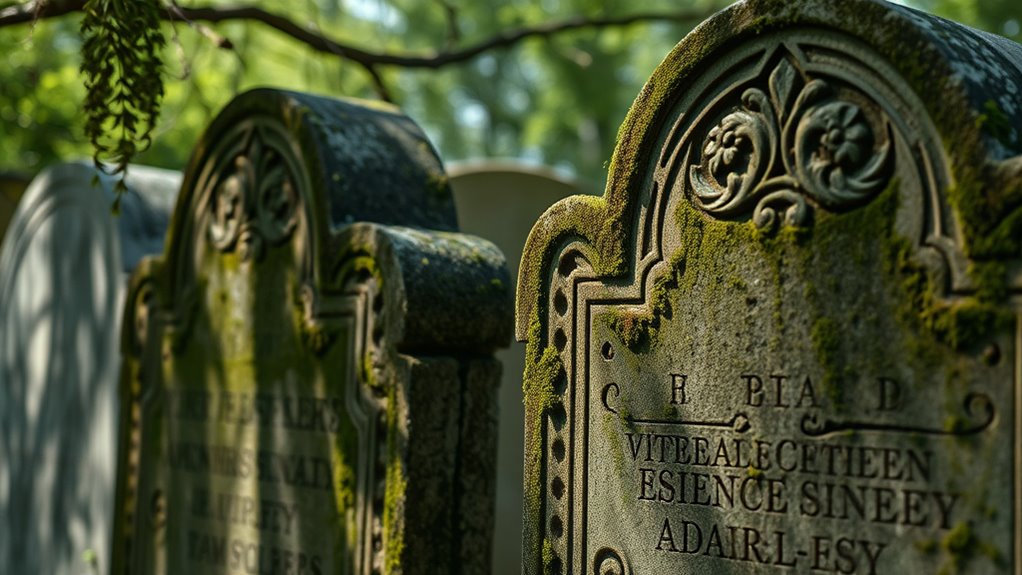
Preserving the integrity of historic headstones is essential to maintaining the cultural and historical significance of our cemeteries. Your role in cultural preservation helps guarantee these artifacts remain meaningful for future generations. Proper maintenance involves careful cleaning and environmental control to prevent deterioration. If a headstone is damaged, artifact restoration techniques can repair chips, cracks, or erosion without compromising its authenticity. Avoid harsh chemicals or abrasive tools that might cause further harm. Instead, use gentle cleaning methods and consult preservation experts when needed. By respecting these markers’ original materials and craftsmanship, you help preserve their historical stories and cultural value. Additionally, understanding the materials used in headstone construction can guide appropriate conservation techniques. Your efforts maintain the dignity of the site and honor those commemorated, ensuring these symbols of the past continue to educate and inspire.
Connecting Stories Through Symbolic Language

Symbols on gravestones serve as a universal language that connects stories across generations. They reveal personal beliefs, cultural values, and historical contexts, allowing you to understand the lives behind each marker. To honor these stories, practice proper cemetery etiquette by avoiding damage and respecting headstone preservation efforts. Recognizing symbolic language helps you interpret the significance of various carvings and motifs, deepening your appreciation for the past. When engaging with old headstones, consider these points:
- Observe the symbols’ meanings to better understand the person’s life and beliefs
- Respect the site by staying on designated paths and refraining from touching or moving stones
- Document and share insights carefully, ensuring preservation for future visitors
- Understanding the vibrational energy of symbols can also enhance your connection to the stories they tell, fostering a deeper sense of respect and empathy.
Connecting stories through symbols enriches your experience and preserves the legacy embedded in each grave.
Frequently Asked Questions
How Do Symbols Vary Across Different Cultures and Regions?
You’ll notice that symbols on headstones vary across different cultures and regions, reflecting diverse beliefs and traditions. Cultural variations influence whether symbols like crosses, angels, or lotus flowers appear, while regional differences might show unique stylistic elements or materials used. By understanding these distinctions, you can better interpret the meaning behind each symbol, respecting the cultural background and significance it holds for those who chose it, fostering a more respectful reading.
Can Symbols Reveal Personal Stories of the Deceased?
Yes, symbols can act like silent storytellers, revealing personal stories of the deceased. When you examine a symbol’s authenticity and emotional significance, you uncover deeper layers of their life. A carved angel might symbolize hope, while a broken rose could hint at lost love. These symbols serve as windows into their soul, offering intimate glimpses into moments that words might never fully capture, making each headstone a heartfelt narrative.
Are There Any Symbols That Are Universally Misunderstood or Misinterpreted?
You should know that some graveyard myths and common misconceptions lead people to misinterpret symbols. For example, the upside-down cross isn’t always associated with evil; it can symbolize humility. Similarly, a broken column might mean life cut short, not failure. These misunderstandings show how symbols are often misunderstood, emphasizing the importance of researching and respecting their true meanings rather than relying on myths or assumptions.
How Can I Distinguish Between Restoration and Damage on Old Headstones?
To distinguish between restoration and damage on old headstones, look for signs of stone cleaning or new materials that don’t match the original. Weathering effects, such as erosion or surface pitting, indicate age-related wear. Restorations often involve patching or smoothing, while damage shows cracks, chips, or uneven surfaces. Carefully compare affected areas with untouched sections to identify genuine weathering versus recent repairs or alterations.
What Are the Best Practices for Photographing and Documenting Symbols Respectfully?
When photographing and documenting symbols, practice respectful photography by avoiding flash and loud noises that might disturb visitors. Respect cultural symbolism by researching their meanings beforehand, ensuring you don’t misinterpret or misuse them. Take clear, close-up shots of individual symbols, noting their location and condition. Always seek permission if needed, and handle headstones gently. Your goal is to preserve their dignity while capturing their historical significance accurately.
Conclusion
By understanding the symbols on old headstones, you connect more deeply with the stories and histories they hold. Approach each marker with respect, recognizing that these symbols serve as a timeless language—much like a secret code from an ancient manuscript—that honors those who rest there. Remember, safeguarding these symbols ensures future generations can appreciate their rich, cultural tapestry, bridging past and present in a way that’s as meaningful as a well-placed quill in a bygone era.










